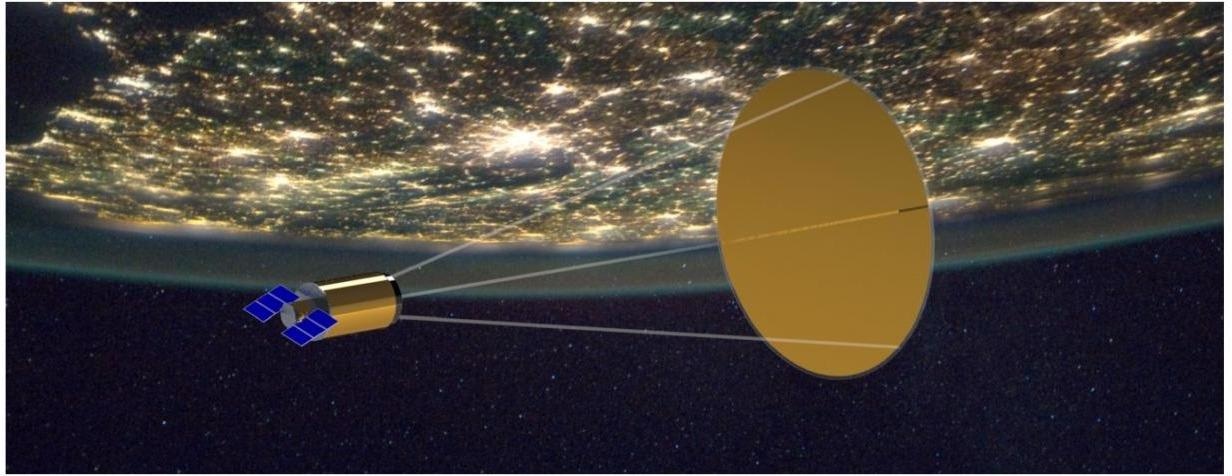Jul 2 2021
Researchers from The University of Arizona, Tucson, AZ, USA, led by Professor Daewook Kim, consider advancements in optical engineering for future telescopes, in a new publication from Opto-Electronic Advances.
 Conceptual rendered image of the OASIS space observatory with a 20-m diameter inflatable primary aperture. Image Credit: Opto-Electronic Advances.
Conceptual rendered image of the OASIS space observatory with a 20-m diameter inflatable primary aperture. Image Credit: Opto-Electronic Advances.
Astronomical advancements are closely tied to technological advancements — ranging from Galileo’s invention of the first optical telescope in 1609 until the foreseeable future, astronomy and optical engineering will be inextricably interwoven.
This study covers a number of advancements that will allow future telescopes to further scientific knowledge of the cosmos. The University of Arizona is making significant optical engineering improvements in the design, manufacture and assembly of next-generation astronomical telescopes.
The study focuses on four significant technological advancements:
- Processes for fabricating next-generation telescope mirrors using optical fabrication techniques.
- Ground-based telescope alignment control and instrumentation advancements, such as laser truss-based active alignment of the Large Binocular Telescope (LBT) prime focus camera and the MOBIUS (Mask-Oriented Breadboard Implementation for Unscrambling Spectra) cross-dispersion spectroscopy unit used at LBT’s prime focal plane.
- Optimization of topological pupil segments.
- Concepts for future space telescopes and technology that will make them possible. The Nautilus space observatory, in particular, necessitates the precise alignment of segmented, multi-order diffractive optical optics. The terahertz space telescope OASIS (Orbiting Astronomical Satellite for Investigating Stellar Systems) presents unique problems while determining the sag of the inflatable primary mirror.
- The Hyperion space telescope pushes the boundaries of far-UV spectroscopy with excellent spectral resolution. The CDEEP (Coronagraphic Debris and Exoplanet Exploring Pioneer) is a SmallSat mission proposal that uses a vector vortex coronagraph to take high-contrast images of circumstellar discs and exoplanets. These advancements in optical engineering technology will aid humanity in surveying, exploring and comprehending the universe.
At the University of Arizona, a wide range of ground-based and space-based future telescope technologies are being hypothesized, planned, prototyped and demonstrated.
Associate Professor Daewook Kim leads the Large Optics Fabrication and Testing (LOFT) group, which studies freeform optical system design, highly-aspheric optical surface figure manufacturing problems and dynamic metrology system advances. As of 2021, Professor Kim and his LOFT colleagues had published over 150 papers.
The LOFT group’s improvements to the Computer Controlled Optical Surfacing (CCOS) technique allows for the more efficient manufacture of future optical elements. Existing huge ground-based or space-based telescopes will be upgraded and expanded using new engineering technologies.
This collection of optical technologies aids the next generation of astronomical research by providing unique and practical ways that will benefit the whole design and engineering community.
Professor Kim hopes that these advances in design and instrumentation will not only set new standards for modern astronomy but will also pave the way for the next major discoveries and inquiries about our cosmos.
Professor Kim continues to work in close coordination with the directors, staff and scientists of different major ground-based and space-based telescope missions, with existing infrastructure.
He believes that continuing to research, develop and apply innovative and advanced optical technologies is critical to the LOFT group’s international contribution and academic service to the optics community for the next generation of advanced optical system design, manufacturing/testing and engineering.
Journal Reference:
Kim, D., et al. (2021) Advances in optical engineering for future telescopes. Opto-Electronic Advances. doi.org/10.29026/oea.2021.210040.
Source: https://compuscript.com/